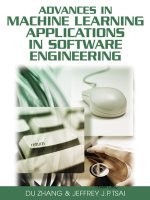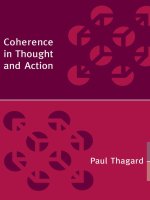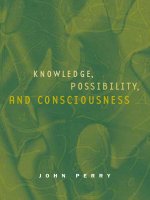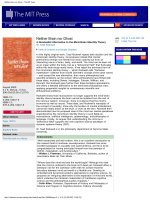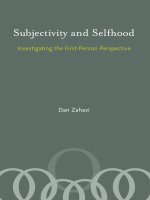the mit press dataset shift in machine learning feb 2009
Bạn đang xem bản rút gọn của tài liệu. Xem và tải ngay bản đầy đủ của tài liệu tại đây (4.39 MB, 246 trang )
DATASET SHIFT IN
MACHINE LEARNING
EDITED BY JOAQUIN QUIÑONERO-CANDELA, MASASHI SUGIYAMA,
ANTON SCHWAIGHOFER, AND NEIL D. LAWRENCE
DATASET SHIFT IN MACHINE LEARNING
QUIÑONERO-CANDELA, SUGIYAMA,
SCHWAIGHOFER, AND LAWRENCE, EDITORS
Dataset shift is a common problem in predictive modeling that
occurs when the joint distribution of inputs and outputs differs
between training and test stages. Covariate shift, a particular
case of dataset shift, occurs when only the input distribution
changes. Dataset shift is present in most practical applications,
for reasons ranging from the bias introduced by experimental
design to the irreproducibility of the testing conditions at
training time. (An example is email spam fi ltering, which may
fail to recognize spam that differs in form from the spam the
automatic fi lter has been built on.) Despite this, and despite
the attention given to the apparently similar problems of semi-
supervised learning and active learning, dataset shift has
received relatively little attention in the machine learning com-
munity until recently. This volume offers an overview of current
efforts to deal with dataset and covariate shift.
The chapters offer a mathematical and philosophical
introduction to the problem, place dataset shift in relationship
to transfer learning, transduction, local learning, active learn-
ing, and semi-supervised learning, provide theoretical views
of dataset and covariate shift (including decision theoretic
and Bayesian perspectives), and present algorithms for covari-
ate shift.
DATASET SHIFT IN
MACHINE LEARNING
EDITED BY JOAQUIN QUIÑONERO-CANDELA,
MASASHI SUGIYAMA, ANTON SCHWAIGHOFER,
AND NEIL D. LAWRENCE
Joaquin Quiñonero-Candela is a Researcher in the Online Services
and Advertising Group at Microsoft Research Cambridge, UK.
Masashi Sugiyama is Associate Professor in the Department of
Computer Science at the Tokyo Institute of Technology. Anton
Schwaighofer is an Applied Researcher in the Online Services
and Advertising Group at Microsoft Research, Cambridge, UK.
Neil D. Lawrence is Senior Research Fellow and Member of the
Machine Learning and Optimisation Research Group in the
School of Computer Science at the University of Manchester.
CONTRIBUTORS
SHAI BEN-DAVID, STEFFEN BICKEL, KARSTEN BORGWARDT, MICHAEL BRÜCKNER, DAVID CORFIELD, AMIR GLOBERSON,
ARTHUR GRETTON, LARS KAI HANSEN, MATTHIAS HEIN, JIAYUAN HUANG, TAKAFUMI KANAMORI, KLAUS-ROBERT MÜLLER,
SAM ROWEIS, NEIL RUBENS, TOBIAS SCHEFFER, MARCEL SCHMITTFULL, BERNHARD SCHÖLKOPF, HIDETOSHI SHIMODAIRA,
ALEX SMOLA, AMOS STORKEY, MASASHI SUGIYAMA, CHOON HUI TEO
Neural Information Processing series
computer science/machine learning
THE MIT PRESS MASSACHUSETTS INSTITUTE OF TECHNOLOGY CAMBRIDGE, MASSACHUSETTS 02142 HTTP://MITPRESS.MIT.EDU
978-0-262-17005-5
Dataset Shift in Machine Learning
Neural Information Processing Series
Michael I. Jordan and Thomas Dietterich, editors
Advances in Large Margin Classifiers, Alexander J. Smola, Peter L. Bartlett,
Bernhard Sch¨olkopf, and Dale Schuurmans, eds., 2000
Advanced Mean Field Methods: Theory and Practice, Manfred Opper and David
Saad, eds., 2001
Probabilistic Models of the Brain: Perception and Neural Function,RajeshP.N.
Rao, Bruno A. Olshausen, and Michael S. Lewicki, eds., 2002
Exploratory Analysis and Data Modeling in Functional Neuroimaging, Friedrich T.
Sommer and Andrzej Wichert, eds., 2003
Advances in Minimum Description Length: Theory and Applications, Peter D.
Grunwald, In Jae Myung, and Mark A. Pitt, eds., 2005
Nearest-Neighbor Methods in Learning and Vision: Theory and Practice, Gregory
Shakhnarovich, Piotr Indyk, and Trevor Darrell, eds., 2006
New Directions in Statistical Signal Processing: From Systems to Brains,Simon
Haykin, Jos´e C. Prncipe, Terrence J. Sejnowski, and John McWhirter, eds., 2007
Predicting Structured Data,G¨okhan Bakır, Thomas Hofmann, Bernhard Sch¨olkopf,
Alexander J. Smola, Ben Taskar, and S. V. N. Vishwanathan, eds., 2007
Toward Brain-Computer Interfacing, Guido Dornhege, Jos´e del R. Mill´an, Thilo
Hinterberger, Dennis J. McFarland, and Klaus-Robert M¨uller, eds., 2007
Large-Scale Kernel Machines,L´eon Bottou, Olivier Chapelle, Denis DeCoste, and
Jason Weston, eds., 2007
Dataset Shift in Machine Learning, Joaquin Qui˜nonero-Candela, Masashi Sugiyama,
Anton Schwaighofer, and Neil D. Lawrence, eds., 2009
Dataset Shift in Machine Learning
Joaquin Qui˜nonero-Candela
Masashi Sugiyama
Anton Schwaighofer
Neil D. Lawrence
The MIT Press
Cambridge, Massachusetts
London, England
c
2009 Massachusetts Institute of Technology
All rights reserved. No part of this book may be reproduced in any form by any electronic
or mechanical means (including photocopying, recording, or information storage and retrieval)
without permission in writing from the publisher.
For information about special quantity discounts, please email special
Typeset by the authors using L
A
T
E
X2
ε
Library of Congress Control No. 2008020394
Printed and bound in the United States of America
Library of Congress Cataloging-in-Publication Data
Dataset shift in machine learning / edited by Joaquin Qui˜nonero-Candela [et al.].
p. cm. — (Neural information processing)
Includes bibliographical references and index.
ISBN 978-0-262-17005-5 (hardcover : alk. paper)
1. Machine learning. I. Qui˜nonero-Candela, Joaquin.
Q325.5.D37 2009
006.3’1–dc22
2008020394
10987654321
Contents
Series Foreword ix
Preface xi
I Introduction to Dataset Shift 1
1 When Training and Test Sets Are Different: Characterizing
Learning Transfer 3
Amos Storkey
1.1 Introduction 3
1.2 ConditionalandGenerativeModels 5
1.3 Real-LifeReasonsforDatasetShift 7
1.4 SimpleCovariateShift 8
1.5 PriorProbabilityShift 12
1.6 SampleSelectionBias 14
1.7 ImbalancedData 16
1.8 DomainShift 19
1.9 SourceComponentShift 19
1.10GaussianProcessMethodsforDatasetShift 22
1.11ShiftorNoShift? 27
1.12DatasetShiftandTransferLearning 27
1.13Conclusions 28
2 Projection and Projectability 29
David Corfield
2.1 Introduction 29
2.2 DataandItsDistributions 30
2.3 DataAttributesandProjection 31
2.4 TheNewRiddleofInduction 32
2.5 NaturalKindsandCauses 34
2.6 MachineLearning 36
2.7 Conclusion 38
v
vi Contents
II Theoretical Views on Dataset and Covariate Shift 39
3 Binary Classification under Sample Selection Bias 41
Matthias Hein
3.1 Introduction 41
3.2 ModelforSampleSelectionBias 42
3.3 Necessary and Sufficient Conditions for the Equivalence of the Bayes
Classifier 46
3.4 BoundingtheSelectionIndexviaUnlabeledData 50
3.5 ClassifiersofSmallandLargeCapacity 52
3.6 A Nonparametric Framework for General Sample Selection Bias
UsingAdaptiveRegularization 55
3.7 Experiments 60
3.8 Conclusion 64
4 On Bayesian Transduction: Implications for the Covariate Shift
Problem 65
Lars Kai Hansen
4.1 Introduction 65
4.2 GeneralizationOptimalLeastSquaresPredictions 66
4.3 BayesianTransduction 67
4.4 BayesianSemisupervisedLearning 68
4.5 ImplicationsforCovariateShiftandDatasetShift 69
4.6 Learning Transfer under Covariate and Dataset Shift: An Example . 69
4.7 Conclusion 72
5 On the Training/Test Distributions Gap: A Data Representation
Learning Framework 73
Shai Ben-David
5.1 Introduction 73
5.2 FormalFrameworkandNotation 74
5.3 ABasicTaxonomyofTasksandParadigms 75
5.4 Error Bounds for Conservative Domain Adaptation Prediction . . . 77
5.5 AdaptivePredictors 83
III Algorithms for Covariate Shift 85
6 Geometry of Covariate Shift with Applications to Active Learning 87
Takafumi Kanamori, Hidetoshi Shimodaira
6.1 Introduction 87
6.2 StatisticalInferenceunderCovariateShift 88
6.3 InformationCriterionforWeightedEstimator 92
6.4 ActiveLearningandCovariateShift 93
Contents vii
6.5 Pool-BasedActiveLeaning 96
6.6 InformationGeometryofActiveLearning 101
6.7 Conclusions 105
7 A Conditional Expectation Approach to Model Selection and
Active Learning under Covariate Shift 107
Masashi Sugiyama, Neil Rubens, Klaus-Robert M¨uller
7.1 Conditional Expectation Analysis of Generalization Error . . . . . . 107
7.2 LinearRegressionunderCovariateShift 109
7.3 ModelSelection 112
7.4 ActiveLearning 118
7.5 ActiveLearningwithModelSelection 124
7.6 Conclusions 130
8 Covariate Shift by Kernel Mean Matching 131
Arthur Gretton, Alex Smola, Jiayuan Huang, Marcel Schmittfull,
Karsten Borgwardt, Bernhard Sch¨olkopf
8.1 Introduction 131
8.2 SampleReweighting 134
8.3 DistributionMatching 138
8.4 RiskEstimates 141
8.5 The Connection to Single Class Support Vector Machines . . . . . . 143
8.6 Experiments 146
8.7 Conclusion 156
8.8 Appendix:Proofs 157
9 Discriminative Learning under Covariate Shift with a Single
Optimization Problem 161
Steffen Bickel, Michael Br¨uckner, Tobias Scheffer
9.1 Introduction 161
9.2 ProblemSetting 162
9.3 PriorWork 163
9.4 DiscriminativeWeightingFactors 165
9.5 IntegratedModel 166
9.6 PrimalLearningAlgorithm 169
9.7 KernelizedLearningAlgorithm 171
9.8 Convexity Analysis and Solving the Optimization Problems . . . . . 172
9.9 EmpiricalResults 174
9.10Conclusion 176
viii Contents
10 An Adversarial View of Covariate Shift and a Minimax
Approach 179
Amir Globerson, Choon Hui Teo, Alex Smola, Sam Roweis
10.1BuildingRobustClassifiers 179
10.2MinimaxProblemFormulation 181
10.3FindingtheMinimaxOptimalFeatures 182
10.4AConvexDualfortheMinimaxProblem 187
10.5AnAlternateSetting:UniformFeatureDeletion 188
10.6RelatedFrameworks 189
10.7Experiments 191
10.8DiscussionandConclusions 196
IV Discussion 199
11 Author Comments 201
Hidetoshi Shimodaira, Masashi Sugiyama, Amos Storkey, Arthur Gretton,
Shai-Ben David
References 207
Notation and Symbols 219
Contributors 223
Index 227
Series Foreword
The yearly Neural Information Processing Systems (NIPS) workshops bring to-
gether scientists with broadly varying backgrounds in statistics, mathematics, com-
puter science, physics, electrical engineering, neuroscience, and cognitive science,
unified by a common desire to develop novel computational and statistical strate-
gies for information processing and to understand the mechanisms for information
processing in the brain. In contrast to conferences, these workshops maintain a
flexible format that both allows and encourages the presentation and discussion
of work in progress. They thus serve as an incubator for the development of im-
portant new ideas in this rapidly evolving field. The series editors, in consultation
with workshop organizers and members of the NIPS Foundation Board, select spe-
cific workshop topics on the basis of scientific excellence, intellectual breadth, and
technical impact. Collections of papers chosen and edited by the organizers of spe-
cific workshops are built around pedagogical introductory chapters, while research
monographs provide comprehensive descriptions of workshop-related topics, to cre-
ate a series of books that provides a timely, authoritative account of the latest
developments in the exciting field of neural computation.
Michael I. Jordan and Thomas G. Dietterich
ix
Preface
Systems based on machine learning techniques often face a major challenge when
applied “in the wild”: The conditions under which the system was developed will
differ from those in which we use the system. An example could be a sophisticated
email spam filtering system that took a few years to develop. Will this system be
usable, or will it need to be adapted because the types of spam have changed since
the system was first built? Probably any form of real world data analysis is plagued
with such problems, which arise for reasons ranging from the bias introduced
by experimental design, to the mere irreproducibility of the testing conditions at
training time.
In an abstract form, some of these problems can be seen as cases of dataset shift,
where the joint distribution of inputs and outputs differs between training and test
stage. However, textbook machine learning techniques assume that training and
test distribution are identical. Aim of this book is to explicitly allow for dataset
shift, and analyze the consequences for learning.
In their contributions, the authors will consider general dataset shift scenarios, as
well as a simpler case called covariate shift. Covariate (input) shift means that only
the input distribution changes, whereas the conditional distribution of the outputs
given the inputs p(y|x) remains unchanged.
This book attempts to give an overview of the different recent efforts that are
being made in the machine learning community for dealing with dataset and
covariate shift. The contributed chapters establish relations to transfer learning,
transduction, local learning, active learning, and to semisupervised learning. Three
recurrent themes are how the capacity or complexity of the model affects its
behavior in the face of dataset shift (are “true” conditional models and sufficiently
rich models unaffected?), whether it is possible to find projections of the data that
attenuate the differences in the training and test distributions while preserving
predictability, and whether new forms of importance reweighted likelihood and
cross-validation can be devised which are robust to covariate shift.
Overview
Part I of the book aims at providing a general introduction to the problem of
learning when training and test distributions differ in some form.
xi
xii Preface
Amos Storkey provides a general introduction in chapter 1 from the viewpoint
of learning transfer. He introduces the general learning transfer problem, and
formulates the problem in terms of a change of scenario. Standard regression and
classification models can be characterized as conditional models. Assuming that the
conditional model is true, covariate shift is not an issue. However, if this assumption
does not hold, conditional modeling will fail. Storkey then characterizes a number
of different cases of dataset shift, including simple covariate shift, prior probability
shift, sample selection bias, imbalanced data, domain shift, and source component
shift. Each of these situations is cast within the framework of graphical models and
a number of approaches to addressing each of these problems are reviewed. Storkey
also introduces a framework for multiple dataset learning that also prompts the
possibility of using hierarchical dataset linkage.
Dataset shift has wider implications beyond machine learning, within philos-
ophy of science. David Corfield in chapter 2 shows how the problem of dataset
shift has been addressed by different philosophical schools under the concept of
“projectability.” When philosophers tried to formulate scientific reasoning with the
resources of predicate logic and a Bayesian inductive logic, it became evident how
vital background knowledge is to allow us to project confidently into the future, or
to a different place, from previous experience. To transfer expectations from one
domain to another, it is important to locate robust causal mechanisms. An im-
portant debate concerning these attempts to characterize background knowledge
is over whether it can all be captured by probabilistic statements. Having placed
the problem within the wider philosophical perspective, Corfield turns to machine
learning, and addresses a number of questions: Have machine learning theorists
been sufficiently creative in their efforts to encode background knowledge? Have
the frequentists been more imaginative than the Bayesians, or vice versa? Is the
necessity of expressing background knowledge in a probabilistic framework too re-
strictive? Must relevant background knowledge be handcrafted for each application,
or can it be learned?
Part II of the book focuses on theoretical aspects of dataset and covariate shift.
In chapter 3, Matthias Hein studies the problem of binary classification under
sample selection bias from a decision-theoretic perspective. Starting from a deriva-
tion of the necessary and sufficient conditions for equivalence of the Bayes classi-
fiers of training and test distributions, Hein provides the conditions under which
–asymptotically– sample selection bias does not affect the performance of a classi-
fier. From this viewpoint, there are fundamental differences between classifiers of
low and high capacity, in particular the ones which are Bayes consistent. In the sec-
ond part of his chapter, Hein provides means to modify existing learning algorithms
such that they are more robust to sample selection bias in the case where one has
access to an unlabeled sample of the test data. This is achieved by constructing
a graph-based regularization functional. The close connection of this approach to
semisupervised learning is also highlighted.
Lars Kai Hansen provides a Bayesian analysis of the problem of covariate shift in
chapter 4. He approaches the problem starting with the hypothesis that it is possible
Preface xiii
to recover performance by tracking the nonstationary input distribution. Under
the average log-probability loss, Bayesian transductive learning is generalization
optimal (in terms of the conditional distribution p(label |input)). For realizable
supervised learning –where the “true” model is at hand– all available data should be
used in determining the posterior distribution, including unlabeled data. However,
if the parameters of the input distribution are disjoint of those of the conditional
predictive distribution, learning with unlabeled data has no effect on the supervised
learning performance. For the case of unrealizable learning –the “true” model is
not contained in the prior– Hansen argues that “learning with care” by discounting
someofthedatamightimproveperformance.Thisisreminiscentoftheimportance-
weighting approaches of Kanamori et al. (chapter 6) and Sugiyama et al. (chapter 7).
In chapter 5, the third contribution of the theory part, Shai Ben-David provides a
theoretical analysis based around “domain adaptation”: an embedding into a feature
space under which training and test distribution appear similar, and where enough
information is preserved for prediction. This relates back to the general viewpoint
of Corfield in chapter 2, who argues that learning transfer is only possible once
a robust (invariant) mechanism has been identified. Ben-David also introduces a
taxonomy of formal models for different cases of dataset shift. For the analysis, he
derives error bounds which are relative to the best possible performance in each
of the different cases. In addition, he establishes a relation of his framework to
inductive transfer.
Part III of the book focuses on algorithms to learn under the more specific setting
of covariate shift, where the input distribution changes between training and test
phases but the conditional distribution of outputs given inputs remains unchanged.
Chapter 6, contributed by Takafumi Kanamori and Hidetoshi Shimodaira, starts
with showing that the ordinary maximum likelihood estimator is heavily biased
under covariate shift if the model is misspecified. By misspecified it is meant
that the model is too simple to express the target function (see also chapter 3
and chapter 4 for the different behavior of misspecified and correct models).
Kanamori and Shimodaira then show that the bias induced by covariate shift
can be asymptotically canceled by weighting the training samples according to the
importance ratio between training and test input densities. However, the weighting
is suboptimal in practical situations with finite samples since it tends to have larger
variance than the unweighted counterpart. To cope with this problem, Kanamori
and Shimodaira provide an information criterion that allows optimal control of the
bias-variance trade-off. The latter half of their contribution focuses on the problem
of active learning where the covariate distribution is designed by users for better
prediction performances. Within the same information-criterion framework, they
develop an active learning algorithm that is guaranteed to be consistent.
In chapter 7 Masashi Sugiyama and coworkers also discuss the problems of
model selection and active learning in the covariate shift scenario, but in a slightly
different framework; the conditional expectation of the generalization error given
training inputs is evaluated here, while Kanamori and Shimodaira’s analysis is in
terms of the full expectation of the generalization error over training inputs and
xiv Preface
outputs. Sugiyama and coworkers argue that the conditional expectation framework
is more data-dependent and thus more accurate than the methods based on the full
expectation, and develop alternative methods of model selection and active learning
for approximately linear regression. An algorithm that can effectively perform active
learning and model selection at the same time is also provided.
In chapter 8 Arthur Gretton and coworkers address the problem of distribution
matching between training and test stages, which is similar in spirit to the problem
discussed in chapter 5. They propose a method called kernel mean matching,which
allows direct estimation of the importance weight without going through density
estimation. Gretton et al. then relate the re-weighted estimation approaches to
local learning, where labels on test data are estimated given a subset of training
data in a neighborhood of the test point. Examples are nearest-neighbor estimators
and Watson-Nadaraya-type estimators. The authors further provide detailed proofs
concerning the statistical properties of the kernel mean matching estimator and
detailed experimental analyses for both covariate shift and local learning.
In chapter 9 Steffen Bickel and coworkers derive a solution to covariate shift
adaptation for arbitrarily different distributions that is purely discriminative: nei-
ther training nor test distribution is modeled explicitly. They formulate the general
problem of learning under covariate shift as an integrated optimization problem and
instantiate a kernel logistic regression and an exponential loss classifier for differing
training and test distributions. They show under which condition the optimiza-
tion problem is convex, and empirically study their method on problems of spam
filtering, text classification, and land mine detection.
Amir Globerson and coworkers take an innovative view on covariate shift: in
chapter 10 they address the situation where training and test inputs differ by
adversarial feature corruption. They formulate this problem as a two-player game,
where the action of one player (the one who builds the classifier) is to choose robust
features, whereas the other player (the adversary) tries to corrupt the features
which would harm the current classifier most at test time. Globerson et al. address
this problem in a minimax setting, thus avoiding any modeling assumptions about
the deletion mechanism. They use convex duality to show that it corresponds to a
quadratic program and show how recently introduced methods for large-scale online
optimization can be used for fast optimization of this quadratic problem. Finally, the
authors apply their algorithm to handwritten digit recognition and spam filtering
tasks, and show that it outperforms a standard support vector machine (SVM)
when features are deleted from data samples.
In chapter 11 some of the chapter authors are given the opportunity to express
their personal opinions and research statements.
Acknowledgements
The idea of compiling this book was born during the workshop entitled “Learning
When Test and Training Inputs Have Different Distributions” that we organized at
Preface xv
the 2006 Advances in Neural Information Processing Systems conference. We would
like to thank the PASCAL Network of Excellence for supporting the organization
of this workshop.
The majority of the chapter authors either gave a talk or were present at the
workshop; the few that weren’t have made major contributions to dealing with
dataset shift in machine learning. Thanks to all of you for making this book happen!
Joaquin Qui˜nonero-Candela
Masashi Sugiyama
Anton Schwaighofer
Neil D. Lawrence
Cambridge, Tokyo, and Manchester, 15 July 2008
I Introduction to Dataset Shift
1 When Training and Test Sets Are Different:
Characterizing Learning Transfer
Amos Storkey
In this chapter, a number of common forms of dataset shift are introduced, and
each is related to a particular form of causal probabilistic model. Examples are
given for the different types of shift, and some corresponding modeling approaches.
By characterizing dataset shift in this way, there is potential for the development
of models which capture the specific types of variations, combine different modes
of variation, or do model selection to assess whether dataset shift is an issue in
particular circumstances. As an example of how such models can be developed, an
illustration is provided for one approach to adapting Gaussian process methods for
a particular type of dataset shift called mixture component shift. After the issue of
dataset shift is introduced, the distinction between conditional and unconditional
models is elaborated in section 1.2. This difference is important in the context
of dataset shift, as it will be argued in section 1.4 that dataset shift makes no
difference for causally conditional models. This form of dataset shift has been called
covariate shift. In section 1.5, another simple form of dataset shift is introduced:
prior probability shift. This is followed by section 1.6 on sample selection bias,
section 1.7 on imbalanced data, and section 1.8 on domain shift. Finally, three
different types of source component shift are given in section 1.9. One example of
modifying Gaussian process models to apply to one form of source component shift is
given in section 1.10. A brief discussion on the issue of determining whether shift
occurs (section 1.11) and on the relationship to transfer learning (section 1.12)
concludes the chapter.
1.1 Introduction
A camera company develops some expert pattern recognition software for their
cameras but now wants to sell it for use on other cameras. Does it need to worry
about the differences?
3
4 When Training and Test Sets Are Different: Characterizing Learning Transfer
The country Albodora has done a study that shows the introduction of a
particular measure has aided in curbing underage drinking. Bodalecia’s politicians
are impressed by the results and want to utilize Albodora’s approach in their own
country. Will it work?
A consultancy provides network intrusion detection software, developed using
machine learning techniques on data from four years ago. Will the software still
work as well now as it did when it was first released? If not, does the company need
to do a whole further analysis, or are there some simple changes that can be made
to bring the software up to scratch?
In the real world, the conditions in which we use the systems we develop will
differ from the conditions in which they were developed. Typically environments are
nonstationary, and sometimes the difficulties of matching the development scenario
to the use are too great or too costly.
In contrast, textbook predictive machine learning methods work by ignoring these
differences. They presume either that the test domain and training domain match,
or that it makes no difference if they do not match. In this book we will be asking
about what happens when we allow for the possibility of dataset shift. What happens
if we are explicit in recognizing that in reality things might change from the idealized
training scheme we have set up?
The scenario can be described a little more systematically. Given some data,
and some modeling framework, a model can be learned. This model can be used
for making predictions P (y|x) for some targets y given some new x.However,if
there is a possibility that something may have changed between training and test
situations, it is important to ask if a different predictive model should be used. To
do this, it is critical to develop an understanding of the appropriateness of particular
models in the circumstance of such changes. Knowledge of how best to model the
potential changes will enable better representation of the result of these changes.
Thereisalsothequestionofwhatneedstobedonedotoimplementtheresulting
process. Does the learning method itself need to be changed, or is there just post
hoc processing that can be done to the learned model to account for the change?
The problem of dataset shift is closely related to another area of study known
by various terms such as transfer learning or inductive transfer. Transfer learning
deals with the general problem of how to transfer information from a variety of
previous different environments to help with learning, inference, and prediction in
a new environment. Dataset shift is more specific: it deals with the business of
relating information in (usually) two closely related environments to help with the
prediction in one given the data in the other(s).
Faced with the problem of dataset shift, we need to know what we can do. If
it is possible to characterize the types of changes that occur from training to test
situation, this will help in knowing what techniques are appropriate. In this chapter
some of the most typical types of dataset shift will be characterized.
The aim, here, is to provide an illustrative introduction to dataset shift. There
is no attempt to provide an exhaustive, or even systematic literature review:
indeed the literature is far too extensive for that. Rather, the hope is that by
1.2 Conditional and Generative Models 5
taking a particular view on the problem of dataset shift, it will help to provide an
organizational structure which will enable the large body of work in all these areas
to be systematically related and analyzed, and will help establish new developments
inthefieldasawhole.
Gaussian process models will be used as illustrations in parts of this chapter.
It would be foolish to reproduce an introduction to this area when there are
already very comprehensible alternatives. Those who are unfamiliar with Gaussian
processes, and want to follow the various illustrations, are referred to Rasmussen
and Williams [2006]. Gaussian processes are a useful predictive modeling tool with
some desirable properties. They are directly applicable to regression problems, and
can be used for classification via logistic transformations. Only the regression case
will be discussed here.
1.2 Conditional and Generative Models
This chapter will describe methods for dataset shift using probabilistic models. A
probabilistic model relates the variables of interest by defining a joint probability
distribution for the values those variables take. This distribution determines which
values of the variables are more or less probable, and hence how particular variables
are related: it may be that the probability that one variable takes a certain value is
very dependent on the state of another. A good model is a probability distribution
that describes the understanding and the occurrence of those variables well. Very
informally, a model that assigns low probability to things that are not observed and
relationships that are forbidden or unlikely and high probability to observed and
likely items is favored over a model that does not.
In the realm of probabilistic predictive models it is useful to make a distinction
between conditional and generative models. The term generative model will be used
to refer to a probabilistic model (effectively a joint probability distribution) over
all the variables of interest (including any parameters). Given a generative model
we can generate artificial data from the model by sampling from the required joint
distribution, hence the name. A generative model can be specified using a number
of conditional distributions. Suppose the data takes the form of covariate x and
target y pairs. Then, by way of example, P(y, x) can be written as P (x|y)P (y),
and may also be written in terms of other hidden latent variables which are not
observable. For example, we could believe the distribution P (y, x) depends on some
other factor r and we would write
P (y, x)=
drP (y, x|r)P (r) , (1.1)
where the integral is a marginalization over the r, which simply means that as r is
never known it needs to be integrated over in order to obtain the distribution for
the observable quantities y and x. Necessarily distributions must also be given for
any latent variables.
6 When Training and Test Sets Are Different: Characterizing Learning Transfer
Conditional models are not so ambitious. In a conditional model the distribution
of some smaller set of variables is given for each possible known value of the other
variables. In many useful situations (such as regression) the value of certain variables
(the covariates) is always known, and so there is no need to model them. Building
a conditional model for variables y given other variables x implicitly factorizes
the joint probability distribution over x and y, as well as parameters (or latent
variables) Θ
x
and Θ
y
,asP (y|x, Θ
y
)P (x|Θ
x
)P (Θ
y
)P (Θ
x
). If the values of x are
always given, it does not matter how good the model P(x) is: it is never used in
any prediction scenario. Rather, the quality of the conditional model P (y|x)isall
that counts, and so conditional models only concern themselves with this term. By
ignoring the need to model the distribution of x well, it is possible to choose more
flexible model parameterizations than with generative models. Generative models
are required to tractably model both the distributions over y and x accurately.
Another advantage of conditional modeling is that the fit of the predictive model
P (y|x) is never compromised in favor of a better fit of the unused model P (x)as
they are decoupled.
If the generative model actually accurately specifies a known generative process
for the data, then the choice of modeling structure may fit the real constraints
much better than a conditional model and hence result in a more accurate param-
eterization. In these situations generative models may fare better than conditional
ones. The general informal consensus is that in most typical predictive modeling
scenarios standard conditional models tend to result in lower errors than standard
generative models. However this is no hard rule and is certainly not rigorous.
It is easy for this terminology to get confusing. In the context of this chapter
we will use the term conditional model for any model that factorizes the joint
distribution (having marginalized for any parameters) as P (y|x)P (x), and the term
unconditional model for any other form of factorization. The term generative model
will be used to refer to any joint model (either of conditional or unconditional form)
which is used to represent the whole data in terms of some useful factorization,
possibly including latent variables. In most cases the factorized form will represent
a (simplified) causal generative process. We may use the term causal graphical model
in these situations to emphasize that the structure is more than just a representation
of some particular useful factorization, but is presumed to be a factorization that
respects the way the data came about.
It is possible to analyze data using a model structure that is not a causal model
but still has the correct relationships between variables for a static environment.
One consequence of this is that it is perfectly reasonable to use a conditional form
of model for domains that are not causally conditional: many forms of model can
be statistically equivalent. If the P (x) does not change, then it does not matter.
Hence conditional models can perform well in many situations where there is no
dataset shift regardless of the underlying beliefs about the generation process for
the data. However, in the context of dataset shift, there is presumed to be an
interventional change to some (possibly latent) variable. If the true causal model
is not a conditional model, then this change will implicitly cause a change to the
1.3 Real-Life Reasons for Dataset Shift 7
relationship P (y|x). Hence the learned form of the conditional model will no longer
be valid. Recognition of this is vital: just because a conditional model performs well
in the context of no dataset shift does not imply its validity or capability in the
context of dataset shift.
1.3 Real-Life Reasons for Dataset Shift
Whether using unconditional or conditional models, there is a presumption that the
distributions they specify are static; i.e., they do not change between the time we
learnthemandthetimeweusethem.Ifthisisnottrue,andthedistributionschange
in some way, then we need to model for that change, or at least the possibility of
that change. To postulate such a model requires an examination of the reasons why
such a shift may occur.
Though there are no doubt an infinite set of potential reasons for these changes,
there are a number of ways of collectively characterizing many forms of shift into
qualitatively different groups. The following will be discussed in this chapter:
Simple covariate shift is when only the distributions of covariates x change and
everything else is the same.
Prior probability shift is when only the distribution over y changes and every-
thing else stays the same.
Sample selection bias is when the distributions differ as a result of an unknown
sample rejection process.
Imbalanced data is a form of deliberate dataset shift for computational or mod-
eling convenience.
Domain shift involves changes in measurement.
Source component shift involves changes in strength of contributing compo-
nents.
Each of these relates to a different form of model. Unsurprisingly, each form
suggests a particular approach for dealing with the change. As each model is
examined in the following sections, the particular nature of the shift will be
explained, some of the literature surrounding that type of dataset shift will be
mentioned, and a graphical illustration of the overall model will be given. The
graphical descriptions will take a common form: they will illustrate the probabilistic
graphical (causal) model for the generative model. Where the distributions of a
variable may change between train and test scenarios, the corresponding network
node is darkened. Each figure will also illustrate data undergoing the particular
form of shift by providing samples for the training (light) and test (dark) situations.
Thesediagramsshouldquicklyillustratethetypeofchangethatisoccurring.Inthe
descriptions, a subscript tr will denote a quantity related to the training scenario,
and a subscript te will denote a quantity relating to the test scenario. Hence P
tr
(y)
and P
te
(y) are the probability of y in training and test situations respectively.
8 When Training and Test Sets Are Different: Characterizing Learning Transfer
Figure 1.1 Simple covariate shift. Here the causal model indicated the targets y are
directly dependent on the covariates x. In other words the predictive function and noise
model stay the same, it is just the typical locations x of the points at which the function
needs to be evaluated that change. In this figure and throughout, the causal model is given
on the left with the node that varies between training and test made darker. To the right
is some example data, with the training data in shaded light and the test data shaded
dark.
1.4 Simple Covariate Shift
The most basic form of dataset shift occurs when the data is generated according
toamodelP (y|x)P (x) and where the distribution P(x) changes between training
and test scenarios. As only the covariate distribution changes, this has been called
covariate shift [Shimodaira, 2000]. See figure 1.1 for an illustration of the form of
causal model for covariate shift.
A typical example of covariate shift occurs in assessing the risk of future events
given current scenarios. Suppose the problem was to assess the risk of lung cancer
in five years (y) given recent past smoking habits (x). In these situations we can
be sure that the occurrence or otherwise of future lung cancer is not a causal factor
of current habits. So in this case a conditional relationship of the form P (y|x)is
a reasonable causal model to consider.
1
Suppose now that changing circumstances
(e.g., a public smoking ban) affect the distribution over habits x. How do we account
for that in our prediction of risk for a new person with habits x
∗
?
It will perhaps come as little surprise that the fact that the covariate distribution
changes should have no effect on the model P(y|x
∗
). Intuitively this makes sense.
The smoking habits of some person completely independent of me should not affect
my risk of lung cancer if I make no change at all. From a modeling point of view
we can see that from our earlier observation in the static case this is simply a
conditional model: it gives the same prediction for given x, P(y|x) regardless of
1. Of course there are always possible confounding factors, but for the sake of this
illustration we choose to ignore that for now. It is also possible the samples are not drawn
independently and identically distributed due to population effects (e.g., passive smoking)
but that too is ignored here.

